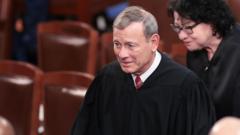The future trajectory of the U.S. clean energy sector hangs in the balance as political leaders present contrasting visions amidst a backdrop of record growth.
Clean Energy's Uncertain Future Amid Election Tug-of-War

Clean Energy's Uncertain Future Amid Election Tug-of-War
As clean energy thrives, upcoming elections may disrupt its momentum.
Over the past two years, the clean energy manufacturing sector in the United States has soared, significantly contributing to the highest rate of factory construction in fifty years. Breakthroughs in solar power installations and unprecedented electric vehicle sales reflect this dynamic shift, even in Republican-led states like Montana and Utah, which are drafting climate action plans to harness federal incentives.
However, the pivotal law that has acted as the catalyst for this transformation—the Inflation Reduction Act of 2022—faces precarious prospects with the impending elections. Former President Donald J. Trump has indicated his intention to dismantle this legislation should he reclaim the White House. Trump has denounced the act as part of a broader agenda targeting climate initiatives, asserting, “My plan will terminate the Green New Deal, which I call the Green New Scam. We will rescind all unspent funds under the misnamed Inflation Reduction Act.”
In stark contrast, Vice President Kamala Harris, who provided the decisive vote for the act in the Senate, advocates for its expansion to catalyze clean energy growth and significantly reduce greenhouse gas emissions. Achieving this goal demands expedited federal permitting processes while also addressing local resistance and limitations within the electric grid.
Although heralded as the most significant climate legislation in U.S. history, experts caution that it is premature to gauge the true impact of the Inflation Reduction Act on the nation’s energy landscape. As the political landscape evolves and voters head to the polls, the future of clean energy hangs in suspense, intertwined with the shifting tides of American governance.
However, the pivotal law that has acted as the catalyst for this transformation—the Inflation Reduction Act of 2022—faces precarious prospects with the impending elections. Former President Donald J. Trump has indicated his intention to dismantle this legislation should he reclaim the White House. Trump has denounced the act as part of a broader agenda targeting climate initiatives, asserting, “My plan will terminate the Green New Deal, which I call the Green New Scam. We will rescind all unspent funds under the misnamed Inflation Reduction Act.”
In stark contrast, Vice President Kamala Harris, who provided the decisive vote for the act in the Senate, advocates for its expansion to catalyze clean energy growth and significantly reduce greenhouse gas emissions. Achieving this goal demands expedited federal permitting processes while also addressing local resistance and limitations within the electric grid.
Although heralded as the most significant climate legislation in U.S. history, experts caution that it is premature to gauge the true impact of the Inflation Reduction Act on the nation’s energy landscape. As the political landscape evolves and voters head to the polls, the future of clean energy hangs in suspense, intertwined with the shifting tides of American governance.






















